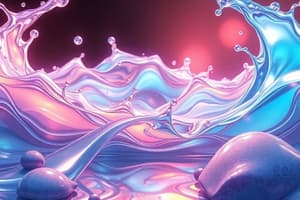Podcast
Questions and Answers
What is the primary reason for the difference in the shape of the meniscus of water and mercury in a narrow tube?
What is the primary reason for the difference in the shape of the meniscus of water and mercury in a narrow tube?
- Water molecules have stronger cohesive forces than mercury molecules.
- Water molecules have stronger adhesive forces to the glass tube than mercury molecules. (correct)
- Mercury is a metal, and water is a non-metal.
- The density of water is greater than the density of mercury.
Which of the following factors directly influences the viscosity of a liquid?
Which of the following factors directly influences the viscosity of a liquid?
- The volume of the liquid
- The intermolecular forces present in the liquid (correct)
- The mass of the liquid
- The color of the liquid
According to the table provided, which hydrocarbon has the weakest intermolecular forces at 20°C?
According to the table provided, which hydrocarbon has the weakest intermolecular forces at 20°C?
- Heptane
- Hexane (correct)
- Nonane
- Octane
In the context of liquids, what does 'dynamic equilibrium' refer to?
In the context of liquids, what does 'dynamic equilibrium' refer to?
Which of the following statements best describes the relationship between viscosity and temperature?
Which of the following statements best describes the relationship between viscosity and temperature?
What is the primary function of surfactants?
What is the primary function of surfactants?
Why is glycerol expected to have a higher viscosity than water?
Why is glycerol expected to have a higher viscosity than water?
How does the surface tension of a liquid affect the shape of the meniscus in a narrow tube?
How does the surface tension of a liquid affect the shape of the meniscus in a narrow tube?
Flashcards
Surface Tension
Surface Tension
The measure of the elastic force in the surface of a liquid.
Cohesive Forces
Cohesive Forces
Forces between molecules in a liquid, causing them to stick together.
Adhesive Forces
Adhesive Forces
Forces between molecules and the surface of another substance.
Capillary Action
Capillary Action
Signup and view all the flashcards
Viscosity
Viscosity
Signup and view all the flashcards
Dynamic Equilibrium
Dynamic Equilibrium
Signup and view all the flashcards
Equilibrium Vapor Pressure
Equilibrium Vapor Pressure
Signup and view all the flashcards
Effect of Temperature on Viscosity
Effect of Temperature on Viscosity
Signup and view all the flashcards
Study Notes
Surface Tension
- Defined as the measure of the elastic force in a liquid's surface
- Illustrated by the image of molecules in a liquid, with stronger attractive forces between surface molecules
Cohesive and Adhesive Forces
- Cohesive forces: Attractive forces between molecules within a liquid
- Adhesive forces: Attractive forces between molecules of a liquid and the surface of another substance (e.g., a container)
- Water exhibits a concave meniscus in a tube due to stronger adhesive forces between water molecules and the glass surface, pulling the liquid upward
- Mercury exhibits a convex meniscus due to stronger cohesive forces within the mercury, causing the liquid to curve downward
Capillary Action
- The rise of liquids up narrow tubes
- Result of competition between cohesive and adhesive forces
- Also known as capillarity
Viscosity
- The measure of a liquid's resistance to flowing
- Increased viscosity corresponds to decreased speed of flow
- Viscosity is related to intermolecular forces (IMFs)
- Increased viscosity results from stronger IMFs and lower temperatures
- Unit of viscosity: poise (P), or Pa-s (Pascals-seconds)
Viscosity of Liquids (Examples)
- Viscosity values are provided for several liquids at 20°C, including acetone, benzene, carbon tetrachloride, diethyl ether, ethanol, glycerol, mercury, and water in Ns/m² units
Viscosity and Molecular Structure
- The structure of glycerol (CH2-OH-CH-OH-CH2-OH) influences its viscosity due to its multiple hydrogen bonding sites and molecular shape
Vapor Pressure of Liquids
- Open container: Some water molecules escape into the air
- Closed container: Water molecules vaporize and condense, eventually reaching equilibrium
- At equilibrium in a closed container, the rate of evaporation equals the rate of condensation
- This equilibrium state creates a vapor pressure within the container
- Vapor pressure is independent of the container's volume
- An increase in the number of gas particles leads to a rise in vapor pressure
Equilibrium Vapor Pressure
- Pressure exerted by a gas in equilibrium with a liquid in a closed container at a specific temperature
- Molecules in the gaseous state above the liquid contribute to the pressure
- Increased number of gas particles leads to increased vapor pressure
- Represents the maximum vapor pressure of a liquid at a given temperature
Vapor Pressure and Temperature
- Vapor pressure increases with temperature
- Molecules gain kinetic energy at higher temperatures, overcoming intermolecular forces and escaping into the gas phase more readily
Vapor Pressure and IMF
- Liquids with high vapor pressure have weak intermolecular forces
- Liquids with low vapor pressure have strong London dispersion forces and strong dipole-dipole forces
Vapor Pressure and IMF (Examples)
- Vapor pressures of pentane, acetone, ethyl alcohol, and water at 25°C are given along with the dominant intermolecular forces.
- The stronger the intermolecular forces, the lower the vapor pressure.
Studying That Suits You
Use AI to generate personalized quizzes and flashcards to suit your learning preferences.




